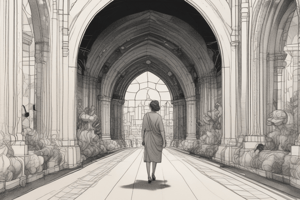Podcast
Questions and Answers
What is the primary role of movement and rhythm in visual arts?
What is the primary role of movement and rhythm in visual arts?
- To emphasize the importance of color
- To create a static composition
- To focus on the subject's facial expression
- To capture the viewer's attention and create a dynamic composition (correct)
What type of lines and brushstrokes can emulate the movement of the subject?
What type of lines and brushstrokes can emulate the movement of the subject?
- Loose and expressive lines (correct)
- Stiff and rigid lines
- Thick and bold lines
- Thin and delicate lines
What technique can suggest movement by intentionally blurring certain elements?
What technique can suggest movement by intentionally blurring certain elements?
- Overlapping elements
- Using sequential panels
- Implying motion through blur (correct)
- Incorporating diagonal lines
What can create a visual rhythm that implies movement?
What can create a visual rhythm that implies movement?
What can introduce a sense of movement by breaking away from horizontal or vertical elements?
What can introduce a sense of movement by breaking away from horizontal or vertical elements?
What is a powerful way to convey movement in a series of artwork?
What is a powerful way to convey movement in a series of artwork?
What is the result of effectively conveying movement in an artwork?
What is the result of effectively conveying movement in an artwork?
What is the purpose of this tutorial?
What is the purpose of this tutorial?
What is the purpose of introducing progressive alteration in design?
What is the purpose of introducing progressive alteration in design?
How can repeated colors or color gradients contribute to visual rhythm?
How can repeated colors or color gradients contribute to visual rhythm?
What is an alternative way to establish visual flow in a design?
What is an alternative way to establish visual flow in a design?
Why is it important to maintain balance and harmony in a design?
Why is it important to maintain balance and harmony in a design?
What should you avoid in your composition to maintain visual rhythm?
What should you avoid in your composition to maintain visual rhythm?
What is the result of incorporating diagonal lines in a design?
What is the result of incorporating diagonal lines in a design?
What should you do to achieve the desired effect in your design?
What should you do to achieve the desired effect in your design?
What is the result of incorporating rhythm in a design?
What is the result of incorporating rhythm in a design?
What can be achieved by illustrating a sequence of actions or moments?
What can be achieved by illustrating a sequence of actions or moments?
Which technique can contribute to the portrayal of movement?
Which technique can contribute to the portrayal of movement?
What can be achieved by creating contrasting elements within your composition?
What can be achieved by creating contrasting elements within your composition?
What can be used to guide the viewer's eye and create a cohesive and harmonious composition?
What can be used to guide the viewer's eye and create a cohesive and harmonious composition?
What can be achieved by repeating patterns in your design?
What can be achieved by repeating patterns in your design?
What can be used to organize design elements and create a sense of order and rhythm?
What can be used to organize design elements and create a sense of order and rhythm?
What can be achieved by gradually changing a visual element as it repeats?
What can be achieved by gradually changing a visual element as it repeats?
What can be used to convey movement within a static image?
What can be used to convey movement within a static image?
What is the result of mastering the art of conveying movement?
What is the result of mastering the art of conveying movement?
What is the focus of the tutorial?
What is the focus of the tutorial?
Flashcards are hidden until you start studying
Study Notes
Conveying Movement and Rhythm in Artwork
- Gestural lines and brushstrokes can convey movement by emulating the subject's movement and guiding the viewer's eye along the composition
- Blurring certain elements can suggest movement, especially for fast-paced actions or subjects in motion
- Overlapping elements create a visual rhythm that implies movement and adds depth to the composition
- Diagonal lines and dynamic angles introduce a sense of movement by breaking away from horizontal or vertical elements
- Sequential panels can capture the passage of time and create the illusion of movement
- Texture can contribute to the portrayal of movement through techniques like stippling, hatching, or flowing brushstrokes
- Contrasting elements, such as static and dynamic elements, can emphasize movement
- Visualizing motion in stillness involves capturing the essence of movement within a static image through dynamic poses, flowing clothing, or implied motion lines
Establishing Rhythm in Visual Design
- Rhythm is essential in visual design to create a sense of movement and unity in compositions
- Consistent shapes and forms can establish rhythm through repetition and variation of visual elements
- Repeating patterns, such as checkerboards or stripes, create a sense of rhythm and unity
- Grid-based layouts provide a structured framework for organizing design elements, creating a sense of order and rhythm
- Progressive alteration involves gradually changing a visual element as it repeats, creating a sense of rhythm and movement
- Repeated colors or color gradients contribute to the establishment of visual rhythm and unity
- Motion and implied movement can establish visual flow through diagonal lines, curves, or overlapping elements
- Balance and harmony are crucial in maintaining a cohesive visual flow and avoiding overcrowding or clutter in the composition
Studying That Suits You
Use AI to generate personalized quizzes and flashcards to suit your learning preferences.




